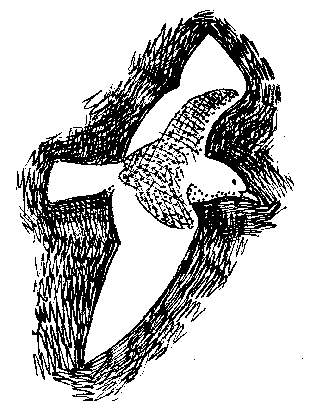
Herts Bird Club Bulletin, covering January and February 1999
Falcated Duck at Tring Reservoirs starts the year with a bang?
Bird summary
The Great Northern Diver, after staying at Hilfield Park reservoir for around nine weeks, finally departed towards the end of January.
Another good coastal bird was a Shag which was seen at Rye Meads in late January. There was a veritable 'boom' in Bittern sightings with possibly as many as 14 birds in the county at various sites. The Little Egret at Tring remained until 24 January and there were two Whooper Swans there earlier in the month.
There were some notable records amongst a good 'collection' of wildfowl species, including the small over-wintering flock of White-fronted Geese near St Albans (possibly two family parties) and the first-winter Falcated Duck found by Graham White at Tring. Potentially a first for Herts if declared wild, it has in its favour its arrival with a large influx of Wigeon and its age as a young bird with not fully developed (falcated) tertials. It was not seen after a duck shoot at Wilstone and either left the area or is now residing in someone's freezer (mmm I wonder if you would cook it a little on the rare side?). Nine Pintails at Tring was a good count with birds also at Hilfield Park Reservoir. A Garganey at Amwell at the end of February was perhaps an early migrant and there was a drake Scaup there to start the year. The Broadwater Long-tailed Duck hopped over the county line on 10 January and there were plenty of records of Smew and Goosander from both the Colne and Lee Valleys.
Raptors were well reported with regular sightings of Red Kites and a mystery eagle species at Barley, which could have been a White-tailed. A Goshawk visited Tring Reservoirs and there were two sightings each of Merlin and Peregrine. Buzzards continued their inexorable increase with as many as 10 in the air together at one site.
Of the 10 species of wader reported, Golden Plover was in particularly good numbers with a single count of 3300 near St Albans. The 'apricot' bird remains with them and the Dunlin reported in the last issue was also there in late February. A number of Woodcocks were found and a single Bar-tailed Godwit.
Gull watching was good, with three Mediterranean Gulls at Tring and others elsewhere. The 'white-winged' Common Gull appeared in the roost at Hilfield as did up to four Kittiwakes, part of a general influx. Both Yellow-legged and the increasingly reported 'Caspian' Gull were seen.

Probably the best ever count of Ring-necked Parakeets was made in Chorleywood will they ever get to be as common as in Surrey?
A Barn Owl was at Amwell and three excellent Short-eared Owls took up residence near Beech Farm.
A Scandinavian Rock Pipit was also at Beech Farm in February whilst elusive Waxwings appeared not far away. Water Pipits reached a high of 10 at Rye Meads in early January. Three Stonechats were found and both Blackcaps and Chiffchaffs fared well in the reasonably mild weather. What was presumably the Holyfield Firecrest wintering in Essex crept over the county boundary in mid January.
Pride of place with passerines was also shared with Essex when a charismatic Great Grey Shrike took up residence in the Stort Valley near Sawbridgeworth. Although it could be difficult to find on occasions, it generally performed well in front of many admirers. Counts of 11 Bramblings at St Albans and 10 at Berkhamsted were supported by a scattering of other, mostly single birds, at other sites in the county. There was a flock of 132 Yellowhammers at Whempstead at the end of January.
Jack Fearnside
Systematic bird sightings for Jan/Feb 1999